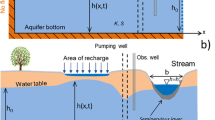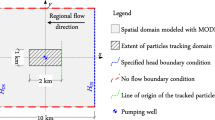Abstract
Three aspects of radial motion of an aquifer solid matrix, driven by hydraulic forces due to well recharge and discharge, have been investigated mathematically. Firstly, the analytic solutions in the velocity and displacement fields were found using the definition of bulk mass flow, conservation of water and solid mass, the Darcy-Gersevanov law, and the drawdown of hydraulic head for unsteady flow. Secondly, the radial velocity and displacement of aquifer solid matrix were investigated with respect to time and location in response to three pumping-injection schemes (i.e., linear, nonlinear, and sinusoidal well flow rates). Aquifer movement was found to be more responsive to linear and nonlinear pumping rates than to constant pumpage. Aquifer movement in response to periodic well discharge and recharge was governed by an integral sinusoidal function. Finally, the potential risk of earth fissuring at a given location caused by tensile stress, in turn induced by well discharge-recharge activity, has been discussed using the analytic solution. The deformation compression and extension zones derived from analysis of the results indicated the possible occurrence of tensile stress that may cause earth fissures. Sample computations, using assumed parameters, provided a first-hand evaluation of the location of potential fissuring in relation to the well.
Résumé
Trois aspects de l’écoulement radial dans un aquifère à matrice solide, du à l’infiltration ou au pompage dans des puits, ont été étudiés mathématiquement. Premièrement, les solutions analytiques des champs de vitesse et de déplacement ont été trouvées suivant la définition de l’écoulement de masse, l’équation de la conservation de la masse, la loi de Darcy-Gersevanov, et le rabattement de la charge hydraulique en régime transitoire. Deuxièmement, la vitesse radiale et l’écoulement ont été investis selon le temps et la position, en réponse à trois types de schémas pompage-injection (pompage linéaire, non linéaire, sinusoïdale). Les écoulements dans l’aquifère sont apparus plus réactifs aux taux de pompage linéaires et non-linéaires qu’aux pompages constants. Les écoulements en réponse à des pompages et des recharges périodiques sont gouvernés par une fonction intégrale sinusoïdale. Finalement, le risque potentiel de fissuration du sol a une localisation donnée et causée par une tension générée par les cycles pompages-recharges, a été discuté suivant la solution analytique. Les zones de déformation, compression et extension, dérivées de l’analyse des résultats sont aussi potentiellement des zones génératrices de fissures. Cette approche utilisant des paramètres choisis avec précautions, permet d’évaluer en première approche la localisation potentielle des fissures autour des puits. Análisis del Movimiento Radial en un Acuífero Confinado debido a Bombeo e Inyección en un Pozo.
Resumen
Se han investigado matemáticamente tres aspectos de movimiento radial en un acuífero de matriz sólida el cual está bajo la influencia de fuerzas hidráulicas que se derivan de recarga y descarga. Primero se encontraron las soluciones analíticas en la velocidad y los campos de desplazamiento usando la definición de flujo de masa volumétrico, conservación de agua y masa sólida, la ley Darcy-Gersevanov, y el descenso de la presión hidráulica para flujo no permanente. Después se investigaron como respondían la velocidad radial y el desplazamiento de la matriz sólida del acuífero, en función del tiempo y localización, con tres esquemas de bombeo-inyección (i.e. ritmos de flujo de pozo linear, no linear, y sinusoidal). Se encontró que el movimiento del acuífero respondía mejor a ritmos de bombeo linear y no linear que a bombeo constante. El movimiento del acuífero en respuesta a la recarga y descarga periódica estuvo determinado por la función sinusoidal integral. Finalmente, se ha discutido, usando una solución analítica, el riesgo potencial de fracturamiento del terreno en una localidad dada ocasionado por esfuerzos de tensión que a su vez son inducidos por actividad de recarga-descarga. Las zonas de deformación compresivas y extensionales derivadas del análisis de los resultados indican la manifestación posible de esfuerzos de tensión que pueden causar grietas en el terreno. Los cálculos en muestras usando parámetros supuestos aportan una evaluación de primera mano de la localización del potencial de fracturamiento en relación al pozo.








Similar content being viewed by others
References
Batu V (1998) Aquifer hydraulic: a comprehensive guide to hydrogeologic data analysis. Wiley, New York
Bear J (1972) Dynamics of fluid through porous material. Elsevier, New York
Biot MA (1941) General theory of three-dimensional consolidation. J Appl Phys 12:155–164
Burbey TJ (1999) Modeling three-dimensional deformation in response to pumping of unconsolidated aquifers. Environ Eng Geosci J 5(2):199–212
Gersevanov NM (1937) The Foundations of dynamics of soils (in Russian), 3rd edn. Stroiizdat, Leningrad
Helm DC (1979) A postulated relation between granular movement and Darcy’s law for transient flow, in evaluation and prediction of subsidence. Am. Soc. of Civil Eng., New York, pp 417–440
Helm DC (1987) Three-dimensional consolidation theory in terms of the velocity of solid. Geotechnique 37:369–392
Helm DC (1994a) Hydraulic forces that plays a role in generating fissures at depth. Bull Assoc Eng Geol 16(3):293–304
Helm DC (1994b) Horizontal aquifer movement in a Theis-Thiem confined aquifer system. Water Resour Res 30(4):953–964
Larsen RW (2000) Introduction to Mathcad 2000. Prentice Hall, Englewood Cliffs, NJ
Li J, Helm DC (1995) A general formulation for aquifer deformation under dynamic and viscous conditions. In: Barends FBJ, Brouwer FJJ, Schroder FH (eds) Proc. of the Land Subsidence 5th Int Symp Land Subsidence, vol 2, Hague, Netherlands, Oct. 1995, pp 323–332
Li J, Helm DC (1998) Viscous drag, driving force and their reduction to Darcy’s law. Water Resour Res 34(7):1675–1684
Mikasa M (1965) The consolidation of soft clay: a new consolidation theory and its application. In: Civil Engineering in Japan, JSCE, Tokyo, pp 21–26
Pyne G, Singer PC, Miller CT (1995) Aquifer storage recovery of treated drink water. Research Report, AWWA Research Foundation and American Water Works Association, Denver, CO
Sheng Z, Helm DC, Li J (2003) Mechanisms of earth fissuring caused by groundwater withdrawal. J Environ Eng Geosci 9(4):313–324
Terzaghi K (1943) Theoretical soil mechanics. Wiley, New York
Theis CV (1935) The relation between the lowering of piezometric surface and the rate and duration of discharge of a well using ground-water storage. Trans Am Geophys Union 16:519–524
Todd DK, Mays LW (2005) Groundwater hydrology. Wiley, New York
Verruijt A (1969) Elastic storage of aquifer. In: DeWeist RLM (ed) Flow through porous media. Academic, New York, pp 331–376
Yerks RF, Castle RO (1969) Surface deformation associated with oil and gas field operation in the United States. In: Tison LJ (ed) Land Subsidence, IASH Publ. 88, IASH, Georgia, pp 55–64
Author information
Authors and Affiliations
Corresponding author
Rights and permissions
About this article
Cite this article
Li, J. Analysis of radial movement of a confined aquifer due to well pumping and injection. Hydrogeol J 15, 445–458 (2007). https://doi.org/10.1007/s10040-006-0087-3
Received:
Accepted:
Published:
Issue Date:
DOI: https://doi.org/10.1007/s10040-006-0087-3




